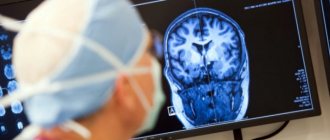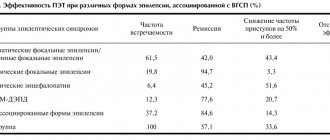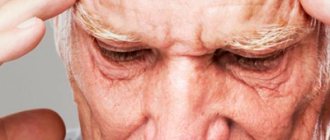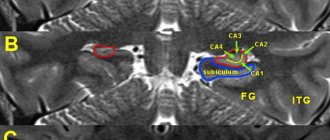The relevance of assessing disability in people with epilepsy within the framework of social medicine and medical and social expertise (MSE) is beyond doubt. This is explained primarily by the social significance of the disease, its high prevalence, the young age of patients, potentially severe consequences, complications and insufficient effectiveness of treatment (in 20-25% of cases) [1].
As you know, WHO lists more than 50 million people with epilepsy in the world, 2/3 of whom are ill in childhood. Every year, 40-70 people out of 100,000 are diagnosed with epilepsy. The prevalence of epilepsy in the general population of Russia is 3.4 per 1000 [2]. About 50% of patients with epilepsy in Russia become disabled over time, and in half of them, ADD reaches a pronounced degree (in 75% of cases these are persons under the age of 30) [3]. In children, epilepsy accounts for 10.5% of diseases of the nervous system, and in 40% of those suffering from organic brain lesions, epileptic seizures are the main reason for contacting the ITU office. In St. Petersburg, among all those recognized as disabled (persons over 18 years old) due to diseases of the nervous system, 7.4% are patients with epilepsy (2015).
The Federal Law “On Social Protection of Persons with Disabilities in the Russian Federation” states: “Medical and social examination is the determination, in the prescribed manner, of the needs of the examined person for social protection measures, including rehabilitation, based on an assessment of the limitations in life activity caused by health problems with persistent functional impairment.” 1.
MSE is carried out based on an assessment of the state of health and the degree of acute respiratory distress based on an analysis of the clinical, social and psychological data of the person being examined.
Assessing CVD in epilepsy requires an integrated approach. Such a clinical expert analysis includes not only an assessment of the frequency and characteristics of paroxysms, but also an assessment of the intellectual potential of a patient with epilepsy, the state of his mental processes and personality, and an analysis of the social data of the witness.
The main maladaptive syndromes in the epilepsy clinic are: paroxysmal, psychoorganic and psychopathic.
If at the initial stage of the disease social maladjustment is caused by paroxysmal phenomena, then as the disease progresses, mental disorders of the non-psychotic register, such as intellectual disability, a gradual increase in changes in mental disorders of the organic type and emerging personality disorders (psychopathic-like symptoms, which are extremely persistent and practically irreducible) [4, 5].
The criterion for establishing the disability of patients with epilepsy is impairment of health of the second degree and more pronounced and persistent dysfunction (in the range from 40 to 100%), leading to a limitation of the II or III degree of severity of one of the main categories of human life or I degree of severity of two categories or more human life activity in their various combinations that determine the need for his social protection2.
Quantitative assessment of the severity of mental dysfunction in epilepsy and epileptic syndromes is based on an analysis of the genesis, type and frequency of epileptic seizures, the time of their occurrence; severity and duration of the post-attack period; age of onset of disease; type of disease; the presence of personality disorders due to illness; the presence, structure and severity of psychoorganic, psychotic, neurosis-like, psychopathic-like, affective and other psychopathological symptoms.
Epileptic seizures in MSE are usually divided according to severity: mild seizures (absences, simple partial seizures, myoclonic); severe attacks (primary and secondary generalized tonic-clonic, astatic, ambulatory automatisms); particularly severe conditions (twilight disorders of consciousness, prolonged dysphoria, serial seizures, status epilepticus).
When conducting MSE, severe paroxysmal conditions with a certain frequency and verified by medical documents are taken into account [6].
The basis for determining disability group III (40-60%) is severe attacks 1-2 times a month; severe dysphoria once a month or less; twilight disorders of consciousness or special states of consciousness once every 1.5 months or less; persistent moderate pathopsychological and psychopathological symptoms, personality changes (disorders) that complicate adaptation in the main areas of life; Disability group II (70-80%) - severe attacks (3 times a month), 5 mild attacks or more per day in the presence of severe psychopathological and pathopsychological symptoms, personality changes (disorders) leading to maladjustment; twilight disorders of consciousness or special states of consciousness once a month, severe dysphoria 2-3 times a month and/or persistent severe pathopsychological and psychopathological symptoms, pronounced personality changes (disorders) leading to maladjustment in the main areas of life; Disability group I (90-100%) - severe attacks 4 times a month or more, 2 twilight disorders of consciousness or more or special states of consciousness, 4 episodes of severe dysphoria or more in combination with significantly pronounced pathopsychological and psychopathological symptoms; significant personality changes (disorders), significant psychoorganic syndrome (POS) or dementia, causing the need for outside care and supervision3.
On what basis can a disabled group be assigned?
Epilepsy is a disease that does not immediately reveal itself. Outwardly, a person is no different from others.
But at the moment of attacks, the patient loses self-control, and therefore can become a very serious danger to others.
It is this reason that can serve as the basis for assigning a disability of one group or another to the patient.
The decision regarding the assignment of a disability group for epilepsy in adults is made by the ITU commission.
It is important to know that not all affected adults are given a disability for epilepsy. The assignment of such status depends on many factors.
Disability for epilepsy in adults is issued immediately if this pathology is congenital and not acquired.
If a person develops a disease in the course of his life, then the reason for obtaining such a status is the loss of working capacity due to the onset of frequent seizures.
Disability is assigned to patients who work at heights, or whose work involves fire, water or complex mechanisms.
During a seizure, a person can harm not only himself, but also others.
Complex partial seizure in epilepsy
The basis for assigning disability for epilepsy for adults can also be his work activity, which is directly related to chemicals, bladed weapons or firearms.
It is possible to apply for disability due to epilepsy in adults if the disease requires constant treatment under the supervision of medical professionals.
That is, if a person is treated in a neurology hospital most of his time or is forced to regularly visit an epileptologist, then these situations serve as the basis for recognizing the person as disabled.
Obtaining this status is also possible if the patient experiences severe side effects from taking medications.
What side effects qualify for disability:
- Mental disorders.
- Lack of ability to self-control the patient's behavior.
- Development of paresis or paralysis.
- Receiving physical injuries due to seizures.
Group I
Clinical examination is a comprehensive medical examination of the population, designed to identify diseases and risk factors, as well as a general assessment of the health status of citizens of the Russian Federation, including: examination of patients, laboratory tests, promotion of a healthy lifestyle and drawing the attention of citizens to the state of health of their body.
Persons under 18 years of age undergo medical examinations annually, and the majority of the adult population - once every three years, starting at established age periods (21, 24, 27, etc. until 39) and annually after 40 years.
In this article we will look at what health groups are distinguished based on the results of medical examination of adults and children, and how they differ.
Health groups for adults
Clinical examination is the main activity for research and monitoring of the health level of the adult population. Based on the information obtained as a result of the medical examination, the doctor or paramedic assigns each citizen a health group in accordance with the requirements and criteria defined in Order of the Ministry of Health of the Russian Federation dated March 13, 2021 N 124n “On approval of the procedure for conducting preventive medical examination and medical examination of certain groups of adults population"
The normative act distinguishes four health groups of the adult population - 1, 2, 3a and 3b.
I includes persons who do not have any chronic diseases, as well as risk factors for the development of such diseases, or who have the indicated risk factors with low or average absolute cardiovascular risk and who do not need clinical observation for other diseases (conditions). ).
The results of laboratory examinations of this group of people are within normal limits. As you might guess, this category includes citizens with the most favorable level of well-being.
Based on the results of the medical examination, preventive consultations and other therapeutic and health measures are carried out for people in this category, with the main goal of promoting a healthy lifestyle and compliance with sanitary and hygienic standards.
Group II
This category includes people who do not have any chronic diseases, but are at increased risk of acquiring them. In addition, this includes people who are predisposed to developing cardiovascular diseases. This group is the largest in number, which is associated with a large number of factors that negatively affect the human body (bad habits, poor diet, sedentary lifestyle, climate pollution, etc.).
This category of citizens is diagnosed by conducting a generally accepted standard health examination, as well as additional studies of individual risks, if any.
II includes citizens who have not been diagnosed with chronic non-infectious diseases, but have risk factors for the development of such diseases
- with high or very high absolute cardiovascular risk,
- as well as citizens who have been diagnosed with obesity and (or) hypercholesterolemia with a total cholesterol level of 8 mmol/l or more, and (or) persons
- smoking more than 20 cigarettes a day,
- and (or) persons with an identified risk of harmful alcohol consumption and (or) a risk of consuming narcotic drugs and psychotropic substances without a doctor’s prescription, and who do not need dispensary observation for other diseases (conditions).
Citizens with health group II with high or very high absolute cardiovascular risk are subject to dispensary observation by a doctor (paramedic) of a department (office) of medical prevention or a health center, as well as a paramedic of a paramedic health center or a paramedic-obstetric station, with the exception of patients with total cholesterol levels 8 mmol/l or more, which are subject to dispensary observation by a general practitioner.
For citizens with health group II, if there are medical indications, the general practitioner prescribes medications for medical use for the purpose of pharmacological correction of identified risk factors.
Group III (a and b)
Group IIIa includes persons suffering from chronic non-communicable diseases (CNCDs), which require dispensary observation and highly qualified medical care. The bulk of citizens in this category are people over 40 years old, whose ailments are directly related to age and aging of the body. Medical examination of such persons is carried out for the purpose of secondary prevention, namely to prevent complications and exacerbations of an existing disease.
Category III b includes persons who have not been diagnosed with chronic non-diseases, but who require the establishment of dispensary observation or the provision of specialized, including high-tech, medical care for other diseases, as well as citizens suspected of having these diseases who require additional examination.
Citizens with III a and III b are subject to dispensary observation by a general practitioner and medical specialists with preventive, therapeutic and rehabilitation measures.
Health groups for children
The health groups identified based on the results of clinical examination of the children's population differ significantly from those of adults. First of all, it is worth saying that there are as many as 5 categories for classifying children (as opposed to 3 for adults).
This amount is associated with the increased vulnerability of the child’s body to various diseases, which is why their clinical examination requires more attention and thoroughness, which ultimately leads to the receipt of a significant amount of information for classification into categories.
1 group
This category includes physically and mentally healthy children who have high body resistance to disease. They can also sometimes get sick, but at the time of examination they do not have any pathologies. In fact, group 1 includes children who are not sick at all, but in practice there are very few such children.
2nd group
This category includes children who do not suffer from chronic diseases, but have reduced immunity. Such babies can suffer acute infections several times a year, but nothing more. They are usually divided into several subgroups according to the type of risk. For example, category “A” includes children with problematic heredity, and “B” includes children at risk of developing chronic diseases.
3 group
Category 3 includes children with any chronic disease. However, patients in this category are distinguished by the fact that such a disease occurs in a state of compensation. This means that, despite the presence of pathology, the child does not face severe consequences or exacerbations of the disease and can lead a normal life.
4 group
This health category denotes children with chronic illnesses in the subcompensation stage. In this state, there is already a significant deterioration in well-being, disruption of the functioning of some organs and reduced body resistance. Such children often need constant treatment and rehabilitation, while their diseases are most often expressed in some kind of physical disability, and their neuropsychic development is normal.
5 group
This category includes children with serious chronic diseases in a state of decompensation. These are disabled children with severe developmental problems or reduced functionality. It is worth noting that diseases of this group are not always congenital. An absolutely healthy child after an illness, surgery or injury can receive group 5. Such children almost always require constant supervision and assistance.
Conclusion
Thus, health groups represent a scale by which the condition of the body, both an adult and a child, is determined.
Taking into account examinations by specialized specialists, the health group is determined by a pediatrician or therapist, who, in turn, carries out a comprehensive assessment of the condition of the human body.
Read also:
- Order of the Ministry of Health of the Republic of Kazakhstan dated December 30, 2015 No. 2158 “On conducting clinical examination of certain groups of the adult population of the Republic of Crimea in 2016”
- Stages of medical examination
- Regulatory acts
- Health groups for adults and children
- Clinical examination. Question answer
- Results of medical examinations and medical examinations in clinical hospital No. 1 for 9 months of 2016
- Working ahead. How medical examination improves health
- Results of medical examinations and medical examinations in KB No. 1 for 2021
- Why undergo medical examination if you feel healthy?
- Free medical examination of the population in 2021: what does it include and who has the right to undergo it?
- Complete information about medical examination
- Ministry of Health: medical examination allowed to increase the detection of cancer by 72%
- All-Russian medical examination has started
- Order of the Ministry of Health of Russia dated March 13, 2019 N 124n “On approval of the procedure for conducting preventive medical examination and medical examination of certain groups of the adult population”
- What diagnostic studies are carried out as part of medical examination at the first stage by age?
- What diagnostic studies are carried out as part of the medical examination at the second stage?
- Medical examination goals
Disability groups for epilepsy in adults
There are 3 groups of disability in epilepsy. Each group has its own characteristics and evaluation criteria.
But, as a rule, people who suffer from:
- Frequent attacks.
- Paresis and paralysis.
- Mental disorders.
- Mental retardation.
- Neurological symptoms.
The group of assigned disability directly depends on the severity of the disease.
The decisive factors in assigning a particular group are:
- Frequency of attacks.
- The effectiveness of the treatment.
- Age category of the patient.
- Electroencephalogram results.
Third group
Criteria for evaluation
This group is assigned to almost 40% of patients. To obtain the status of a group 3 disabled person, the patient must have partial partial seizures.
With them, localization occurs only in one part of the brain.
These seizures can occur with or without loss of consciousness. The main characteristic of simple partial seizures is a sudden change in mood and feelings. The patient may experience joy, anger and sadness in a short period of time.
A complex partial seizure is characterized by loss of consciousness, which is accompanied by the appearance of convulsions, frequent blinking or convulsive curling of the lips.
Diagnosis by a doctor of the severity of epilepsy for granting disability
To receive group 3, simple seizures must occur several times a day, and complex seizures up to 3 times a month. Also the basis for assigning group 3 is myalgia.
This is a disease that is characterized by muscle pain due to hypertonicity of muscle cells.
People with epilepsy who received group 3 do not suffer from mental or cognitive impairment.
Second group
Criteria for evaluation
Group 2 is received by about 55% of patients with epilepsy. It is assigned if a person suffers from simple partial seizures more than 6 times a day.
Complex partial seizures when receiving group 2 should occur more than 4 times a month.
About 55% of patients with epilepsy receive disability group 2
Typically, patients experience psychological disorders and impairments of cognitive abilities (impaired memory, attention, concentration, perception, etc.).
Disabled people of group 2 are also characterized by paresis (decreased strength of any organ or part of the body).
First group
Criteria for evaluation
Disability group 1 is assigned to only 5% of the total number of patients with epilepsy.
To qualify for this group, an adult must suffer from severe mental and neurological disorders, as well as dementia.
Group 1 disabled people are patients who have completely lost the ability to care for themselves.
Such people have paresis, impaired vision, hearing and ability to speak.
Process of registration of disability for epilepsy
A mandatory condition for conferring the status of a disabled person is passing a medical and social examination.
The referral is issued by the doctor under whose supervision the patient is.
Based on the results of the examination, a special commission makes a decision regarding the advisability of receiving one of the disability groups.
Referrals to MSE are issued to individuals who pose a danger to people around them during their work activities due to the onset of seizures.
Also, people who do not experience positive dynamics in the treatment of the disease have the right to undergo a medical examination.
Distribution of patients with epilepsy by disability group
Patients whose health condition is deteriorating even despite taking medications are also referred to ITU.
Compulsory medical examination is required for patients who experience pathological changes in mental health and intelligence.
After passing the medical examination and receiving the results, the patient must contact the ITU office and submit documentation.
After submitting the papers, the commission sends the patient for an additional examination, based on the results of which it will make a decision regarding obtaining the status of a disabled person.
If the decision is positive, then the commission, within a month after receiving disability, develops an individual plan for the rehabilitation of the patient.
How to get disability?
When it comes to applying for disability, you should make an appointment with a neurologist. It is he who will issue a referral to visit all the required doctors and undergo the relevant tests.
Thus, the mandatory conditions should be considered:
- complete analysis of both blood and urea;
- X-ray of the skull in several projections (preferably in at least two);
- examination of the fundus and visual functions;
- echo-EG;
- electroencephalography (EEG);
- if seizures and deterioration of the condition began less than six months ago, then it is necessary to conduct a computed tomography (CT) or magnetic resonance imaging (MRI);
- psychotherapist's decision.
After visiting all the doctors and passing the listed tests, the neurologist is obliged to:
- issue a referral for medical and social examination (MSE) in accordance with form number 088/a-06;
- refer the epileptic to a special commission, where the presence of the disease will be checked, as well as the correctness of filling out all documentation.
After this, the package of documents will be certified by the signature and seal of the head physician of the medical institution. This concludes the first stage. At the next stage, the person must come to the ITU office, where the exact timing of the examination will be indicated.
If a person is recognized as disabled, he will be given a certificate of receipt of one or another disability group. In addition, the medical committee must develop an individual rehabilitation plan (IRP) within 30 days from the date of the decision. Only after approval of the created program, within three days it should be sent to the department of social protection at the place of residence of the epileptic, or it should be handed over to him at the regional ITU office.
After all the required documents have been received, it is necessary to contact the social protection authorities and the pension fund in order for the appropriate benefits, allowances and pension payments to be issued.
What is permanent disability?
There is also the concept of permanent disability, which is assigned to those patients who were previously included in the first or second group. At the same time, the epileptic is faced with a permanent loss of ability to work, and all therapeutic and preventive measures for five years turned out to be ineffective.
Thus, receiving a disability group for epilepsy gives a person more than just social protection. This is an opportunity to work without any problems, receive legal payments and compensation, as well as adequate medical care.
Author of the article:
Sokov Andrey Vladimirovich |
Neurologist Education: In 2005, she completed an internship at the First Moscow State Medical University named after I.M. Sechenov and received a diploma in the specialty “Neurology”. In 2009, she completed her postgraduate studies in the specialty “Nervous Diseases”. Our authors










